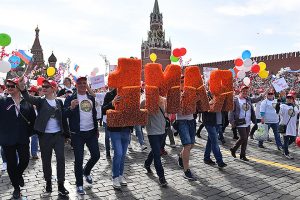
The first of May is one of the most celebrated holidays in the world, which is known under several names at once such as International Worker’s Solidarity Day, Spring and Labor Day, etc. In more than 50 countries, it is officially declared as a day off. However, in one country, on this holiday, people gather under the banners of trade unions, while in another it’s just another day off. Russia has an interesting view and philosophy about this particular holiday.
In modern Russia, the festive culture is undergoing rapid transformations: some holidays leave active life, others change their meaning and forms of celebration, others arise and begin to become popular. Under these conditions, May Day turns out to be one of the few ideologically saturated Soviet holidays that managed to successfully adapt to the new sociocultural realities and maintain wide popularity.
May Day and Paganism
May Day is known to most Russians as a holiday of the communist era, which survived political changes and remained on the calendar as a red date. However, its roots go back to the distant past. For the ancient Romans, it was a day of solemn sacrifice in honor of the goddess Maya – the patroness of the earth and fertility, the eldest of the Pleiades, daughters of the Titans Atlanta and the oceanic Pleion. With the spread of Christianity in the early Middle Ages in Europe, this holiday acquired a dual character. On the one hand, representatives of the Church tried to rid society of pagan “remnants” and reduce this day to simple festivities and holiday springtime outdoor recreation. But the pagan essence of the holiday has not disappeared.
Modern history
In the modern sense, May Day appeared in the middle of the 19th century, when Australian workers demanded an eight-hour working day and marched on a demonstration. On May 1, 1886, anarchists from Canada and the United States, following the example of Australian workers, staged demonstrations and rallies in which six people died. In response to police brutality in Chicago, demonstrators detonated a bomb, killing eight police officers and injuring about 50 others. There was also a shootout.
Eight anarchists were sentenced to death on charges of organizing an explosion, but the main witness admitted that he had slandered them, and the three anarchists were commuted to hard labor. Later it was possible to prove that the defendants were indeed not involved in the explosion. In 1889, in memory of the executed anarchists, the Paris Congress of the Second International declared the date May 1 as the Day of Solidarity of Workers of the World.
Celebration in Russia
In the Russian Empire, this holiday was first celebrated in 1890 in Warsaw by the May Day strike of workers. The following year, the first May Day celebration took place in St. Petersburg – a meeting of revolutionary-minded workers outside the city, which got its name from traditional May Day celebrations.
May Day became an official holiday only after the October Revolution of 1917. In 1918, it was enshrined in the Code of Labor Laws and received the name International Day. In the post-war period, the May Day demonstrations changed the semantic meaning: in 1970, the Fundamentals of the USSR legislation on labor assigned a new name to the holiday – Days of the International Solidarity of Workers. In 1992, after the collapse of the USSR, the holiday was renamed the Festival of Spring and Labor, however, the traditional socio-political May Day demonstrations and rallies are held to this day.
If in the first years of Soviet power, May Day was perceived by many residents as an imposed holiday, which was celebrated exclusively in the form of official celebrations, then later unofficial traditions of its celebration began to take shape. As a rule, the organized official part (May Day demonstration) took place in the morning, after which the columns of the participants in the celebration dispersed, and everyone was given the opportunity to continue to celebrate the holiday in a more informal setting. If the weather was favorable, then often held feasts in nature: work colleagues, uniting in small companies, could arrange something like picnics, where the use of alcoholic beverages played an important role.
May 1, for the Russians, starts a long holiday weekend, which ends on May 5. Mini-vacation opens May Day – a holiday with a rich history, which in many countries of the world has been celebrated since the 19th century. However, according to opinion polls, in recent years, many Russians perceive May Day only as an additional day off and do not consider it a special date. May 1 in Russia is commonly celebrated as the holiday of Spring and Labor. In Soviet times, this date was called the International Day and the Day of International Workers’ Solidarity; the holiday was politically colored. May Day was a symbol of the implacable class struggle and revolution, but gradually this context was lost. According to the latest opinion polls, many Russians do not perceive May Day as a holiday of labor, for them this is only the beginning of the garden season and an additional day off in the year.
n general, the organized forms of celebrating May Day are not very common at present, but the informal formats of the celebration that arose in Soviet times are in full bloom. In the 2000s, in an era of rapid growth in economic prosperity, high-income Russians formed the tradition of the May holidays: taking a vacation on the days between the May holidays, they arranged a trip for a week and a half; all travel companies prepared package deals specifically for the May holidays.
